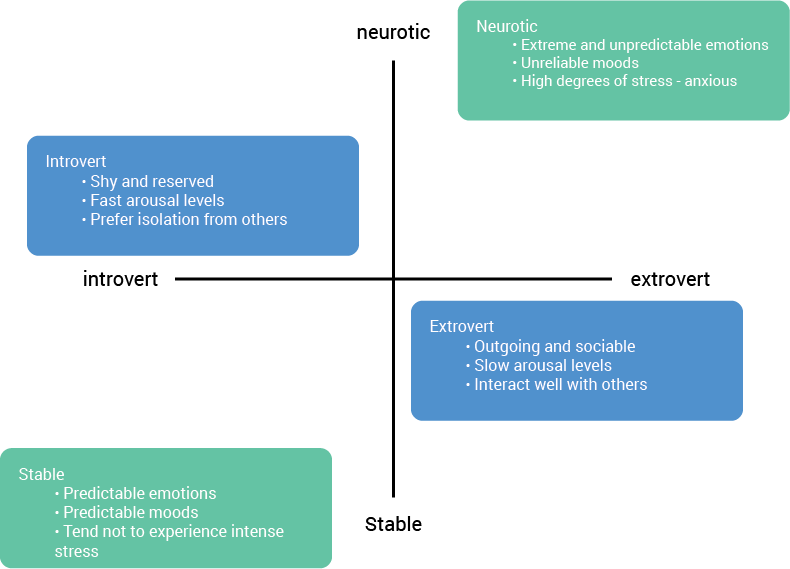Content
- Personality - theories, types, profiling
- Motivation – intrinsic/extrinsic, achievement motivation, self confidence
- Stress, arousal and anxiety
Sports psychology is the study of people and their behaviours in sport. For both the athlete and coach this area is as important as physical training and performance analysis. Success is being attributed to motivation, focus and being in the zone, as well as team cohesion.
This is the unique pattern of behaviour and characteristics a person/athlete displays. Some psychologists believe success or failure on the sports pitch is determined by personality.
“Personality is the more or less stable and enduring organisation of a persons character, temperament, intellect and physique which determines the unique adjustment to the environment”
There are a number of theories and approaches that try to explain personality and how it can influence participation and performance. The main theories are:
Personality is inherent and is within the athletes genes, inherited from their parents. This theory maintains that all behaviour is innate and a person has a natural tendency to act in any given situation. These behaviours are consistent and can be measured through questionnaires (CASTELLS 16 PF). The problem with this theory is that it does not take into account adapting behaviour to the environment or that behaviour is not always predictable.
Trait theory has two main dimensions to personality:

Eysenck proposed that there were 4 personality types:
Other Trait theorists propose that there are two types of personality:
| Type A | Type B |
|---|---|
| Highly competitive Desire to succeed Need to be in control Prone to stress |
Non-competitive Lacks desire to succeed Does not enjoy control Less prone to stress |
Personality is learned through environmental experiences and the influence of others. It is therefore not stable but constantly changing as a result of social situations. Personality evolves through modelling and reinforcement; modelling themselves on athletes they can relate to and behaviour being positively reinforced and therefore repeated.
Bandura identified four main stages of observational learning:
Attention
Learn through observation
Certain levels of respect for the model
Retention
Must be able to remember skill or behaviour and recall it.
Motor reproduction
Must be physically able to perform task observed
Time to practice
Motivational response
Athlete needs to be motivated or they will not go through the first 3 stages
Motivation is dependant upon reinforcement
However this theory does not take into account genetically inherent factors and therefore offers one view into why there are individual differences in the participation and performance.
Sheldon noted that personality was categorised into three personalities based on physical make-up. Personality was demonstrated based on physical attributes and the relationship between build and behaviour. The three categorises include:
The Endomorph is physically quite 'round', and is typified as the 'barrel of fun' person. They tend to have:
Psychologically, the endomorph is: Sociable, fun-loving, tolerant, even-tempered, relaxed
The Ectomorph is a form of opposite of the Endomorph. Physically, they tend to have:
Even though they may eat as much as the endomorph, they never seem to put on weight (much to the endomorph's chagrin). Psychologically they are: Self-conscious, introverted, inhibited, socially anxious, intense, thoughtful
The mesomorph is somewhere between the round endomorph and the thin ectomorph. Physically, they have the more 'desirable' body, and have:
They are generally considered as 'well-proportioned'. Psychologically, they are: Adventurous, courageous, assertive, competitive, risk taker, extroverted. Psychologically, the endomorph is: Sociable, fun-loving, tolerant, even-tempered, relaxed
Personality is a result of inherent traits and learned experiences. It is widely agreed that it is a combination of both theories that explains behaviour. Hollander (1967) used the concentric ring theory to explain the interactionist approach.

The boundary line of each layer gets wider as you get closer to the centre of the model, which shows that each layer is harder to enter. As you move closer to the centre, your ‘real’ personality begins to surface
There has been a large amount of research to try to demonstrate a relationship between personality and sporting behaviour, success and participation.
Like physical training and biomechanical analysis is it also important to psychological profile, in order to identify strengths and improve limitations. To assessment can be achieved through:
A combination of the above methods will help identify behaviour and personalities. The careful analysis of results could aid motivation and adherence.
Castell’s 16PF questionnaire (Trait Theory)
This is a test that measures normal personality (trait)
Sport Competition Anxiety Test (Martens 1977)
This teat attempts to predict behaviour in a competitive situation (trait)